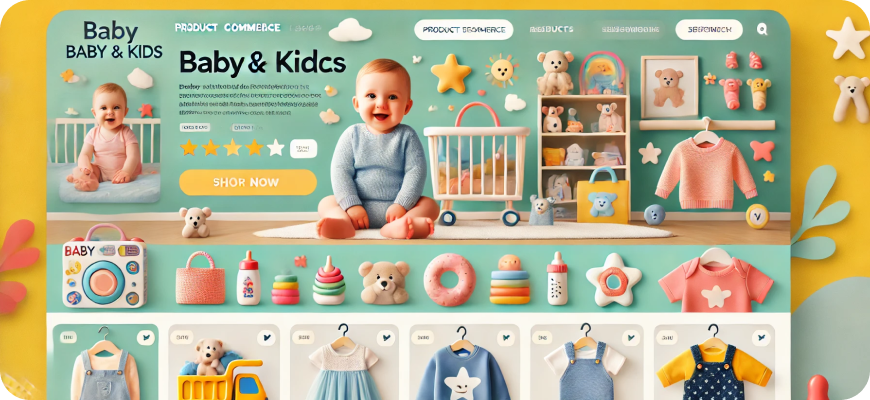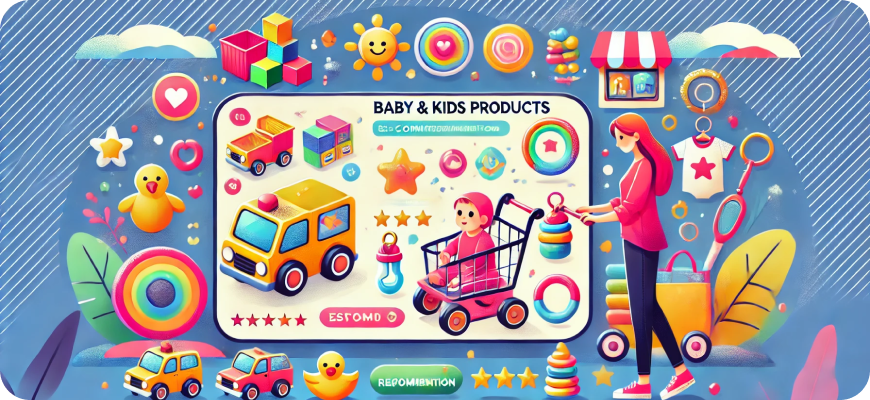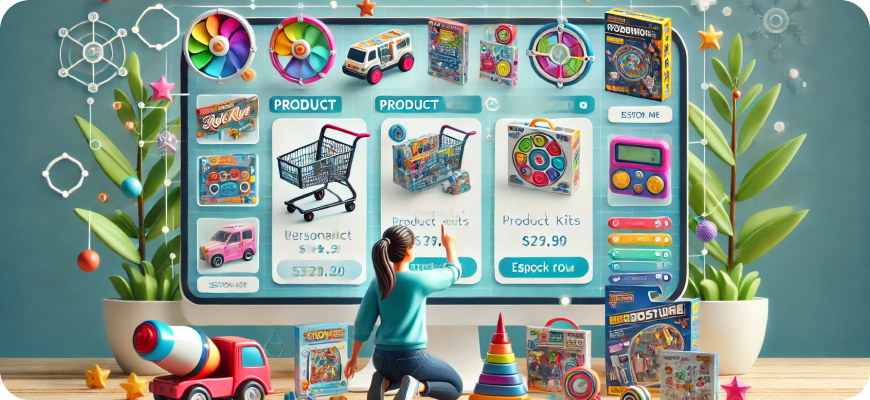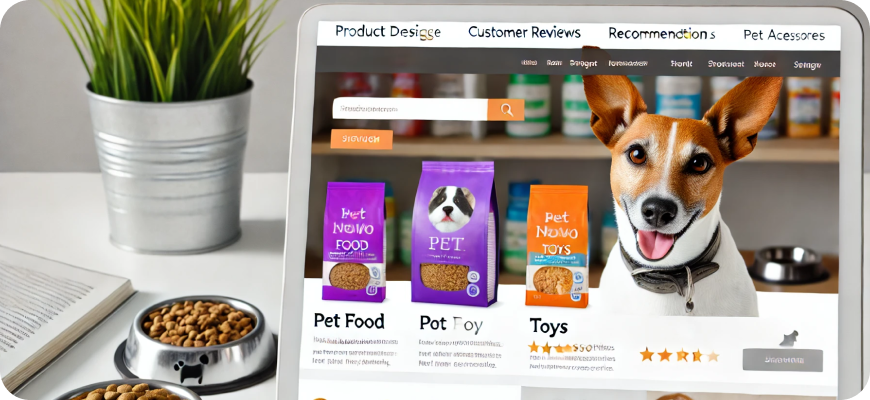Ecommerce Best Practices for Baby & Kids
The baby and kids e-commerce market is unique and highly competitive, requiring brands to address the needs of parents and caregivers while ensuring the safety, quality, and appeal of their products. From clothing, toys, and nursery essentials to educational materials and baby gear, the sector offers tremendous opportunities. Success in this space hinges on providing an exceptional customer experience, building trust with parents, and offering innovative solutions that cater to the needs of children at different developmental stages.
Here’s a comprehensive guide to e-commerce best practices for the baby and kids sector.

1. Prioritize High-Quality Visual Content
Parents want to see exactly what they are purchasing for their children. High-quality visuals help build confidence and highlight product value:
- Multiple Product Images: Use high-resolution images to showcase products from various angles. Include close-ups of key features, such as materials, safety mechanisms, and textures.
- Lifestyle Photos: Feature children or babies using the products in real-life settings. This helps parents visualize how the items might look or function in their homes.
- Product Videos: Create engaging videos that demonstrate product usage, assembly instructions, or key features in action.
2. Focus on Safety and Compliance
Safety is a top priority for parents and caregivers when purchasing products for their children:
- Safety Certifications: Clearly display safety certifications (e.g., ASTM, CPSC, CE) and compliance with relevant standards for toys, clothing, or baby gear.
- Age Recommendations: Provide clear age-appropriateness labels, safety warnings, and guidelines for each product.
- Detailed Safety Information: Include information on non-toxic materials, safety mechanisms (e.g., secure straps on baby carriers), and any additional features that enhance safety.
3. Offer Detailed Product Descriptions and Specifications
Parents need comprehensive information to make informed decisions:
- Materials and Care Instructions: Clearly state the materials used in your products and provide care instructions for clothing, toys, or gear.
- Product Dimensions and Weight Limits: Include measurements, weight capacities, and other relevant specifications for items like cribs, strollers, or high chairs.
- Educational Value: Highlight any educational or developmental benefits of toys or learning materials.
4. Leverage Personalization and Product Recommendations
Personalization can help parents find the right products for their child’s needs:
- Customizable Baby Registries: Allow parents to create and share customizable baby registries for events like baby showers.
- AI-Driven Recommendations: Use AI to suggest products based on browsing history, previous purchases, and customer preferences.
- Tailored Bundles: Offer product bundles tailored to different needs, such as “Newborn Essentials,” “Toddler Playtime,” or “Back-to-School Kits.”
5. Optimize for Mobile Shopping
Many parents shop on their mobile devices for convenience:
- Responsive Mobile Design: Ensure your website is mobile-friendly, with fast loading times, intuitive navigation, and touch-friendly buttons.
- Mobile Checkout Optimization: Simplify the checkout process with mobile-friendly forms, auto-fill options, and support for digital wallets like Apple Pay and Google Pay.
- Mobile Apps: Consider developing a mobile app that offers personalized experiences, loyalty rewards, and app-exclusive promotions.
6. Provide Flexible Payment and Financing Options
Baby and kids’ products can be costly, so offering flexible payment options can increase accessibility:
- Buy Now, Pay Later (BNPL) Services: Partner with BNPL providers like Klarna, Afterpay, or Affirm to offer flexible payment plans.
- Multiple Payment Options: Accept various payment methods, including credit/debit cards, digital wallets, and bank transfers.
- Subscription Services: Offer subscriptions for regularly purchased items, such as diapers, wipes, or educational materials, providing convenience for parents.
7. Create Engaging Content and Community Resources
Parents often seek advice, community support, and engaging content:
- Parenting Blogs and Articles: Write informative content on topics like child development, parenting tips, and product guides (e.g., “How to Choose the Right Stroller” or “Top Educational Toys for Toddlers”).
- Product How-To Guides: Create videos and guides demonstrating product assembly, usage, and care.
- Interactive Content: Offer quizzes and tools to help parents find the right products, such as “Which Baby Carrier is Best for You?” or “Back-to-School Essentials Quiz.”
8. Highlight Sustainability and Eco-Friendly Practices
Sustainability is a growing concern among parents:
- Sustainable Materials: Highlight eco-friendly products made from organic or sustainably sourced materials.
- Eco-Friendly Packaging: Use recyclable, minimal, or biodegradable packaging and communicate your commitment to sustainability.
- Green Initiatives: Share your brand’s efforts in supporting environmental causes or collaborating with organizations focused on children’s welfare.
9. Offer Exceptional Customer Support
Providing responsive and empathetic customer support is crucial for parents:
- Live Chat and Chatbots: Offer live chat support for instant responses to questions about product safety, returns, or recommendations.
- Comprehensive FAQ Section: Maintain a detailed FAQ section addressing common concerns about safety, sizing, assembly, and product use.
- Order Follow-Ups: Send follow-up emails after purchases to ensure satisfaction, solicit feedback, and provide product tips.
10. Leverage Social Proof with Reviews and Testimonials
Social proof builds trust and helps parents make decisions:
- Customer Reviews and Ratings: Display verified reviews, including both positive and negative feedback, to give an honest representation of your products.
- User-Generated Content (UGC): Encourage customers to share photos and stories about how their children use your products. Feature this content on your website and social channels.
- Expert Endorsements: Collaborate with pediatricians, child development specialists, or parenting influencers to review and endorse your products.
11. Streamline the Checkout Process
Reducing friction in the checkout process minimizes cart abandonment:
- Guest Checkout Option: Allow customers to make purchases without creating an account.
- Progress Indicators: Show progress bars during the checkout process to reduce uncertainty and increase completion rates.
- Auto-Fill and Security Measures: Use auto-fill for payment and shipping information and ensure robust data security measures to protect customer information.
12. Emphasize Fast and Reliable Shipping
Parents often need products quickly, especially for essential items:
- Multiple Shipping Options: Offer expedited, same-day, or next-day shipping for essentials like diapers, formula, or health supplies.
- Real-Time Order Tracking: Provide customers with real-time tracking to monitor their shipments from dispatch to delivery.
- Subscription Delivery Preferences: Allow customers to customize delivery dates and frequencies for subscription products.
13. Highlight Promotions and Seasonal Campaigns
Promotions can create excitement and drive sales:
- Holiday-Themed Sales: Offer promotions around major holidays, such as Christmas, Mother’s Day, or Back-to-School season.
- Limited-Time Offers: Use flash sales or limited-time discounts to create urgency and encourage immediate purchases.
- Bundle Deals: Create special bundles, such as “Baby’s First Year Essentials” or “School Supplies Combo,” at a discounted price.
14. Use Data Analytics for Continuous Optimization
Data-driven insights can help refine and improve your e-commerce strategy:
- Customer Behavior Analysis: Track customer behavior, including browsing patterns, purchase history, and preferences, to offer personalized experiences.
- A/B Testing: Conduct A/B tests on product pages, checkout flows, and promotional messages to determine what resonates best with your audience.
- Retention Metrics: Monitor customer retention rates, repeat purchase rates, and churn rates to identify areas for improvement.
15. Offer Loyalty Programs and Referral Incentives
Loyalty programs and referral incentives encourage repeat purchases and engagement:
- Points-Based Rewards Program: Reward customers for purchases, reviews, referrals, or birthdays. Points can be redeemed for discounts, exclusive products, or gifts.
- Exclusive Perks for Members: Offer early access to sales, special discounts, or limited-edition items for loyalty program members.
- Referral Programs: Incentivize customers to refer friends by offering discounts or rewards for both the referrer and the new customer.
16. Collaborate with Influencers and Parenting Experts
Influencer partnerships can increase brand visibility and credibility:
- Parenting Influencer Collaborations: Partner with parenting influencers to create authentic content, reviews, or tutorials showcasing your products.
- Expert Advice Panels: Collaborate with pediatricians, educators, or child development specialists to offer expert advice, tips, and recommendations.
- Workshops and Live Events: Host live events, Q&A sessions, or webinars on parenting topics or product use.
17. Optimize for SEO and Content Marketing
Optimized content can drive organic traffic and establish your brand as an industry leader:
- Keyword Optimization: Target relevant keywords in product pages, blog posts, and metadata, such as “Best Baby Bottles for Newborns” or “Educational Toys for Toddlers.”
- Content Creation: Publish valuable content, including parenting guides, product reviews, and themed articles. Examples include “Back-to-School Shopping Tips” or “Top Safety Tips for New Parents.”
- Local SEO Optimization: If you have physical stores, optimize your content for local searches related to baby and kids’ products.
18. Ensure Compliance with Regulations
Compliance with safety and regulatory standards is critical in the baby and kids sector:
- Product Testing and Certification: Ensure that products meet relevant safety standards and display certifications.
- Clear Labeling: Provide accurate labeling, including age recommendations, materials used, and safety warnings.
- Recall Procedures: Have a clear process in place for addressing product recalls and ensuring customer safety.
19. Use Interactive and Immersive Content
Interactive content can engage parents and simplify buying decisions:
- Product Customization Tools: Allow customers to personalize products, such as custom clothing, engraved toys, or name-embroidered items.
- Augmented Reality (AR) Experiences: Offer AR tools that enable customers to visualize furniture in their nursery or see how clothing fits their child.
- Quizzes and Tools: Create quizzes to help parents find products that match their child’s needs, such as “Which Stroller Fits Your Lifestyle?”
20. Build a Sense of Community
Community engagement fosters loyalty and trust:
- Online Forums and Groups: Create spaces for parents to connect, share advice, and discuss your products.
- User Challenges and Contests: Host challenges or contests encouraging customers to share photos or stories featuring your products.
- Social Media Engagement: Use social media to connect with customers, share parenting tips, and showcase user-generated content.

Conclusion
E-commerce success in the baby and kids sector requires a focus on safety, trust, and personalized customer experiences. By providing high-quality visuals, flexible payment options, engaging content, and robust customer support, brands can build loyalty and stand out in this competitive market. Following these best practices ensures that your e-commerce platform meets the needs of parents and caregivers, creating a memorable and satisfying shopping experience.
This guide outlines key strategies and techniques to optimize your e-commerce operations, enhance customer satisfaction, and build lasting connections in the baby and kids industry.






